At Il Cinema Ritrovato 2015 (27 June - 4 July 2015) in Bologna, a new, multi-year project starts with brand new restorations of the films of Buster Keaton (1895–1966). The Keaton Project will be launched with the screening of the silent short One Week (1920) and with the silent feature Sherlock Jr. (1924), an early example of film within a film. The film showcases all of Buster Keaton’s virtues: his deadpan humour, his innovative technical accomplishments, his amazing stunts and perfect gags. The two restorations will be presented tonight in Piazza Maggiore in Bologna accompanied live by Timothy Brock’s original scores and performed by the Bologna Opera House Orchestra.
Image may be NSFW.
Clik here to view.
German postcard by Ross Verlag, no. 4704/1, 1929-1930. Photo: MGM. Publicity still for The Hollywood Revue of 1929 (Charles Reisner, 1929) with Keaton as Princess Raja. This performance must have been inspired by the Egyptian dance in The Cook (Roscoe 'Fatty' Arbuckle, 1918).
Image may be NSFW.
Clik here to view.
German postcard by Ross Verlag, no. 1834/1, 1927-1928. Photo: Fanamet. Publicity still for Spite Marriage (Edward Sedgewick, Buster Keaton, 1929).
Buster Keaton was born Joseph Frank Keaton in 1895 into a vaudeville family. His father was Joseph Hallie ‘Joe’ Keaton, who owned a travelling show with Harry Houdini called the Mohawk Indian Medicine Company. Keaton was born in Piqua, Kansas, the small town where his mother, Myra Keaton (née Myra Edith Cutler), happened to go into labour.
By the time he was 3, Keaton began performing with his parents in The Three Keatons. He was being thrown around the stage and into the orchestra pit, or even into the audience. His little suits even had a handle concealed at the waist, so Joe could sling him like luggage. "It was the roughest knockabout act that was ever in the history of the theatre," Keaton told the historian Kevin Brownlow. It led to accusations of child abuse, and occasionally, arrest. However, Buster Keaton was always able to show the authorities that he had no bruises or broken bones.
Noticing that his laughing drew fewer laughs from the audience, Keaton adopted his famous deadpan expression whenever he was working. For the rest of his career, Keaton was 'the great stone face', with an expression that ranged from the impassive to the slightly quizzical.
By the time he was 21, his father's alcoholism threatened the reputation of the family act, so Keaton and his mother, Myra, left for New York, where Buster Keaton's career swiftly moved from vaudeville to film. In February 1917, Keaton met Roscoe ‘Fatty’ Arbuckle at the Talmadge Studios in New York City, where Arbuckle was under contract to Joseph M. Schenck. He was hired as a co-star and gag man, making his first appearance in the short The Butcher Boy (Roscoe 'Fatty' Arbuckle, 1917).
Keaton appeared in a total of 14 Arbuckle shorts, running into 1920. They were popular and, Keaton and Arbuckle became close friends. Keaton was one of few people to defend Arbuckle's character during accusations that he was responsible for the death of actress Virginia Rappe in 1921.
In The Saphead (Herbert Blaché, Winchell Smith, 1920), Keaton had his first starring role in a full-length feature. It was a success and Schenck gave him his own production unit, Buster Keaton Comedies. He made a series of two-reel comedies, including One Week (Edward F. Cline, Buster Keaton, 1920), The Boat (Edward F. Cline, Buster Keaton, 1921), Cops (Edward F. Cline, Buster Keaton, 1922), and The Paleface (Edward F. Cline, Buster Keaton, 1922).
Keaton then moved to full-length features. His first feature, Three Ages (Edward F. Cline, Buster Keaton, 1923), was produced similarly to his short films, and was the dawning of a new era in comedic cinema, where it became apparent to Keaton that he had to put more focus on the story lines and characterization. His most enduring features include Our Hospitality (John G. Blystone, Buster Keaton, 1923), The Navigator (Donald Crisp, Buster Keaton, 1924), Sherlock Jr. (Buster Keaton, 1924), College (James W. Horne, Buster Keaton, 1927), and The General (Clyde Bruckman, Buster Keaton, 1927).
My favourite is The General, set during the American Civil War. The film combines physical comedy with Keaton's love of trains, including an epic locomotive chase. Employing picturesque locations, the film's storyline re-enacted an actual wartime incident. Though it would come to be regarded as Keaton's greatest achievement, the film received mixed reviews at the time. It was too dramatic for some filmgoers expecting a lightweight comedy. It was an expensive misfire, and Keaton was never entrusted with total control over his films again. His distributor, United Artists, insisted on a production manager who monitored expenses and interfered with certain story elements.
Image may be NSFW.
Clik here to view.![Buster Keaton]()
Belgian postcard by Ed. Weekblad Cinema, Antwerpen. French written caption: Buster Keaton, born in 1895, on the stage 24 hours after his birth, in the arms of his father.
Buster Keaton endured this treatment by United Artists for two more feature films, including Steamboat Bill Jr. (Charles Reisner, Buster Keaton, 1928), and then exchanged his independent setup for employment at Hollywood's biggest studio, Metro-Goldwyn-Mayer (MGM). Keaton's loss of independence as a filmmaker coincided with the coming of sound films (although he was interested in making the transition) and mounting personal problems.
In 1921, Keaton had married Natalie Talmadge, sister-in-law of his boss, Joseph Schenck, and sister of actresses Norma Talmadge and Constance Talmadge. She co-starred with Keaton in Our Hospitality. The couple had two sons, James (1922-2007) and Robert (1924–2009), but after the birth of Robert, the relationship began to suffer. Influenced by her family, Talmadge decided not to have any more children and this led to the couple staying in separate bedrooms. Her financial extravagance (she would spend up to a third of his salary on clothes) was another factor in the breakdown of the marriage.
Keaton signed with MGM in 1928, a business decision that he would later call the worst of his life. He realized too late that MGM’s studio system would severely limit his creative input. For instance, the studio refused his request to make his early project, Spite Marriage (Edward Sedgwick, Buster Keaton, 1929), as a sound film and after the studio converted, he was obliged to adhere to dialogue-laden scripts.
However, MGM did allow Keaton some creative participation on his last originally developed/written silent film The Cameraman (Edward Sedgwick, Buster Keaton, 1928). which was his first project under contract with them. Keaton was forced to use a stunt double during some of the more dangerous scenes, something he had never done in his heyday, as MGM wanted badly to protect its investment.
Some of his most financially successful films for the studio were during this period. MGM tried teaming the laconic Keaton with the rambunctious Jimmy Durante in a series of films, The Passionate Plumber (Edward Sedgwick, 1932), Speak Easily (Edward Sedgwick, 1932), and What! No Beer? (Edward Sedgwick, 1933).
In the first Keaton pictures with sound, he and his fellow actors would shoot each scene three times: one in English, one in Spanish, and one in either French or German. The actors would phonetically memorize the foreign-language scripts a few lines at a time and shoot immediately after.
In 1932, Nathalie Talmadge had divorced Keaton, taking his entire fortune and refusing to allow any contact between Keaton and his sons, whose last name she had changed to Talmadge. Keaton was reunited with them about a decade later when his older son turned 18. With the failure of his marriage, and the loss of his independence as a filmmaker, Keaton lapsed into a period of alcoholism.
Image may be NSFW.
Clik here to view.![Buster Keaton, Anita Page, Cliff Edwards]()
Dutch postcard by JosPe, no. 310. Photo: Metro-Goldwyn-Mayer (MGM). Publicity still for Sidewalks of New York (Zion Myers, Jules White, 1931).
Buster Keaton was so demoralized during the production of What! No Beer? (Edward Sedgwick, 1933) that MGM fired him after the filming was complete, despite the film being a resounding hit. In 1933, he married his nurse, Mae Scriven, during an alcoholic binge about which he afterwards claimed to remember nothing. Scriven herself would later claim that she didn't know Keaton's real first name until after the marriage. When they divorced in 1936, it was again at great financial cost to Keaton.
In 1934, Keaton accepted an offer to make an independent film in Paris, Le Roi des Champs-Élysées/The King of the Champs Elysees (Max Nosseck, 1934) with Paulette Dubost. In England, he made another film, The Invader/An Old Spanish Custom (Adrian Brunel, 1936).
Upon Keaton's return to Hollywood, he made a screen comeback in a series of 16 two-reel comedies for Educational Pictures. Most of these are simple visual comedies, with many of the gags supplied by Keaton himself, often recycling ideas from his family vaudeville act and his earlier films. The high point in the Educational series is Grand Slam Opera (Buster Keaton, Charles Lamont, 1936), featuring Buster in his own screenplay as a contestant in a radio amateur hour show hoping to win the first price... by dancing and juggling.
When the series lapsed in 1937, Keaton returned to MGM as a gag writer, including the Marx Brothers films At the Circus (Edward Buzzell, 1939) and Go West (Edward Buzzell, 1940), and providing material for Red Skelton. He also helped and advised Lucille Ball in her comedic work in films and television. In 1939, Columbia Pictures hired Keaton to star in ten two-reel comedies, running for two years. The director was usually Jules White, whose emphasis on slapstick and farce made most of these films resemble White's Three Stooges comedies. Keaton's personal favourite was the series' debut entry, Pest from the West (Del Lord, 1939), a shorter, tighter remake of The Invader (1936). Keaton's Columbia shorts rank as the worst comedies he made.
Image may be NSFW.
Clik here to view.![Charlie Chaplin]()
Charlie Chaplin. East-German collectors card, no. III/18/211, 1955. Photo: United Artists. Publicity still for Limelight (1952).
Buster Keaton's personal life stabilized with his 1940 marriage with Eleanor Norris, a 21-year-old dancer. She stopped his heavy drinking, and helped to salvage his career. He abandoned Columbia for the less strenuous field of feature films. Throughout the 1940s, Keaton played character roles in features. He made his last starring feature El Moderno Barba Azul/Boom In The Moon (Jaime Salvador, 1946) in Mexico.
Critics rediscovered Keaton in 1949. He had cameos in such films as In the Good Old Summertime (Robert Z. Leonard, 1949), Sunset Boulevard (Billy Wilder, 1950), and Around the World in 80 Days (Michael Anderson, 1956), and did innumerable TV appearances. Keaton also appeared in a comedy routine about two inept stage musicians in Charlie Chaplin's Limelight (1952).
In 1954, Keaton and his wife met film programmer Raymond Rohauer, with whom the couple would develop a business partnership to re-release Keaton's films. Around the same time, after buying the comedian's house, the actor James Mason found numerous cans of Keaton's films. Keaton had prints of the features Three Ages, Sherlock, Jr., Steamboat Bill, Jr., College (missing one reel) and the shorts The Boat and My Wife's Relations, which Keaton and Rohauer transferred to safety stock from deteriorating nitrate film stock. Unknown to them at the time, MGM also had saved some of Keaton's work: all his 1920-1926 features and his first eight two-reel shorts.
In 1962 came a retrospective at the Cinematheque Francaise in Paris, and in 1965 a tribute at the Venice Film Festival. "I can't feel sorry for myself," he said in Venice. "It all goes to show that if you stay on the merry-go-round long enough you'll get another chance at the brass ring. Luckily, I stayed on."
In 1960, Keaton had returned to MGM for the final time, playing a lion tamer in an adaptation of Mark Twain's The Adventures of Huckleberry Finn (Michael Curtiz, 1960). Later Keaton played a cameo in It's a Mad, Mad, Mad, Mad World (Stanley Kramer, 1963) and starred in four films for American International Pictures: Pajama Party (Don Weis, 1964), Beach Blanket Bingo (William Asher, 1965), How to Stuff a Wild Bikini (William Asher, 1964) and Sergeant Deadhead (Norman Taurog, 1964). As he had done in the past, Keaton also provided gags for the four AIP films.
In 1965, Keaton starred in the short film The Railrodder (Gerald Potterton, Buster Keaton, 1965) for the National Film Board of Canada. Wearing his traditional pork pie hat, he travelled from one end of Canada to the other on a railway motorcar, performing a few stunts similar to those in films he did 50 years earlier. The film was Keaton's last silent screen performance.
He also played the central role in Samuel Beckett's Film (Alan Schneider, 1965) and travelled to Italy to play a role in Due Marines e un Generale/War Italian Style (Luigi Scattini, 1965), with Italian comedy duo Franco Franchi and Ciccio Ingrassia.
Keaton's final film was A Funny Thing Happened on the Way to the Forum (Richard Lester, 1966) which was filmed in Spain in September-November 1965. He amazed the cast and crew by doing many of his own stunts. Shortly after completing the film, Keaton died of lung cancer in 1966 at his home in Woodland Hills, California. He was 70. In 1987, the documentary, Buster Keaton: A Hard Act to Follow, directed by Kevin Brownlow and David Gill, won two Emmy Awards.
One Week (1920). Source: (YouTube).
Trailer for The General (1927). Source: Fandor Movie Trailers (YouTube).
The Railrodder (1965). Source: NFB (YouTube).
Sources: Roger Ebert, Nicolette Olivier (IMDb), New York Times, Wikipedia, and IMDb.
Image may be NSFW.
Clik here to view.
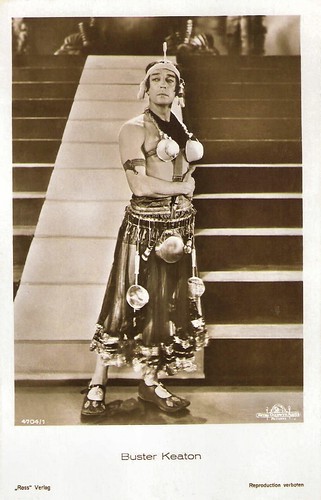
German postcard by Ross Verlag, no. 4704/1, 1929-1930. Photo: MGM. Publicity still for The Hollywood Revue of 1929 (Charles Reisner, 1929) with Keaton as Princess Raja. This performance must have been inspired by the Egyptian dance in The Cook (Roscoe 'Fatty' Arbuckle, 1918).
Image may be NSFW.
Clik here to view.
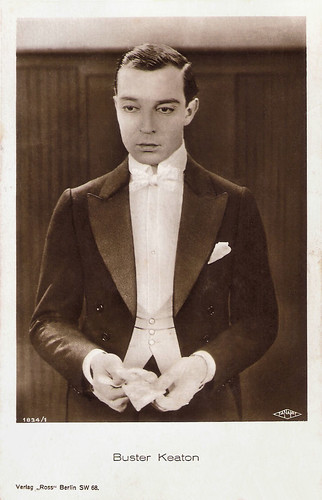
German postcard by Ross Verlag, no. 1834/1, 1927-1928. Photo: Fanamet. Publicity still for Spite Marriage (Edward Sedgewick, Buster Keaton, 1929).
The great stone face
Buster Keaton was born Joseph Frank Keaton in 1895 into a vaudeville family. His father was Joseph Hallie ‘Joe’ Keaton, who owned a travelling show with Harry Houdini called the Mohawk Indian Medicine Company. Keaton was born in Piqua, Kansas, the small town where his mother, Myra Keaton (née Myra Edith Cutler), happened to go into labour.
By the time he was 3, Keaton began performing with his parents in The Three Keatons. He was being thrown around the stage and into the orchestra pit, or even into the audience. His little suits even had a handle concealed at the waist, so Joe could sling him like luggage. "It was the roughest knockabout act that was ever in the history of the theatre," Keaton told the historian Kevin Brownlow. It led to accusations of child abuse, and occasionally, arrest. However, Buster Keaton was always able to show the authorities that he had no bruises or broken bones.
Noticing that his laughing drew fewer laughs from the audience, Keaton adopted his famous deadpan expression whenever he was working. For the rest of his career, Keaton was 'the great stone face', with an expression that ranged from the impassive to the slightly quizzical.
By the time he was 21, his father's alcoholism threatened the reputation of the family act, so Keaton and his mother, Myra, left for New York, where Buster Keaton's career swiftly moved from vaudeville to film. In February 1917, Keaton met Roscoe ‘Fatty’ Arbuckle at the Talmadge Studios in New York City, where Arbuckle was under contract to Joseph M. Schenck. He was hired as a co-star and gag man, making his first appearance in the short The Butcher Boy (Roscoe 'Fatty' Arbuckle, 1917).
Keaton appeared in a total of 14 Arbuckle shorts, running into 1920. They were popular and, Keaton and Arbuckle became close friends. Keaton was one of few people to defend Arbuckle's character during accusations that he was responsible for the death of actress Virginia Rappe in 1921.
In The Saphead (Herbert Blaché, Winchell Smith, 1920), Keaton had his first starring role in a full-length feature. It was a success and Schenck gave him his own production unit, Buster Keaton Comedies. He made a series of two-reel comedies, including One Week (Edward F. Cline, Buster Keaton, 1920), The Boat (Edward F. Cline, Buster Keaton, 1921), Cops (Edward F. Cline, Buster Keaton, 1922), and The Paleface (Edward F. Cline, Buster Keaton, 1922).
Keaton then moved to full-length features. His first feature, Three Ages (Edward F. Cline, Buster Keaton, 1923), was produced similarly to his short films, and was the dawning of a new era in comedic cinema, where it became apparent to Keaton that he had to put more focus on the story lines and characterization. His most enduring features include Our Hospitality (John G. Blystone, Buster Keaton, 1923), The Navigator (Donald Crisp, Buster Keaton, 1924), Sherlock Jr. (Buster Keaton, 1924), College (James W. Horne, Buster Keaton, 1927), and The General (Clyde Bruckman, Buster Keaton, 1927).
My favourite is The General, set during the American Civil War. The film combines physical comedy with Keaton's love of trains, including an epic locomotive chase. Employing picturesque locations, the film's storyline re-enacted an actual wartime incident. Though it would come to be regarded as Keaton's greatest achievement, the film received mixed reviews at the time. It was too dramatic for some filmgoers expecting a lightweight comedy. It was an expensive misfire, and Keaton was never entrusted with total control over his films again. His distributor, United Artists, insisted on a production manager who monitored expenses and interfered with certain story elements.
Image may be NSFW.
Clik here to view.
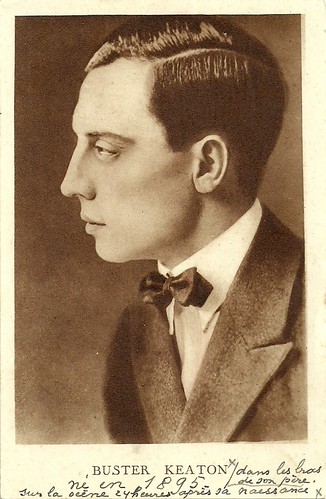
Belgian postcard by Ed. Weekblad Cinema, Antwerpen. French written caption: Buster Keaton, born in 1895, on the stage 24 hours after his birth, in the arms of his father.
The worst decision of his life
Buster Keaton endured this treatment by United Artists for two more feature films, including Steamboat Bill Jr. (Charles Reisner, Buster Keaton, 1928), and then exchanged his independent setup for employment at Hollywood's biggest studio, Metro-Goldwyn-Mayer (MGM). Keaton's loss of independence as a filmmaker coincided with the coming of sound films (although he was interested in making the transition) and mounting personal problems.
In 1921, Keaton had married Natalie Talmadge, sister-in-law of his boss, Joseph Schenck, and sister of actresses Norma Talmadge and Constance Talmadge. She co-starred with Keaton in Our Hospitality. The couple had two sons, James (1922-2007) and Robert (1924–2009), but after the birth of Robert, the relationship began to suffer. Influenced by her family, Talmadge decided not to have any more children and this led to the couple staying in separate bedrooms. Her financial extravagance (she would spend up to a third of his salary on clothes) was another factor in the breakdown of the marriage.
Keaton signed with MGM in 1928, a business decision that he would later call the worst of his life. He realized too late that MGM’s studio system would severely limit his creative input. For instance, the studio refused his request to make his early project, Spite Marriage (Edward Sedgwick, Buster Keaton, 1929), as a sound film and after the studio converted, he was obliged to adhere to dialogue-laden scripts.
However, MGM did allow Keaton some creative participation on his last originally developed/written silent film The Cameraman (Edward Sedgwick, Buster Keaton, 1928). which was his first project under contract with them. Keaton was forced to use a stunt double during some of the more dangerous scenes, something he had never done in his heyday, as MGM wanted badly to protect its investment.
Some of his most financially successful films for the studio were during this period. MGM tried teaming the laconic Keaton with the rambunctious Jimmy Durante in a series of films, The Passionate Plumber (Edward Sedgwick, 1932), Speak Easily (Edward Sedgwick, 1932), and What! No Beer? (Edward Sedgwick, 1933).
In the first Keaton pictures with sound, he and his fellow actors would shoot each scene three times: one in English, one in Spanish, and one in either French or German. The actors would phonetically memorize the foreign-language scripts a few lines at a time and shoot immediately after.
In 1932, Nathalie Talmadge had divorced Keaton, taking his entire fortune and refusing to allow any contact between Keaton and his sons, whose last name she had changed to Talmadge. Keaton was reunited with them about a decade later when his older son turned 18. With the failure of his marriage, and the loss of his independence as a filmmaker, Keaton lapsed into a period of alcoholism.
Image may be NSFW.
Clik here to view.
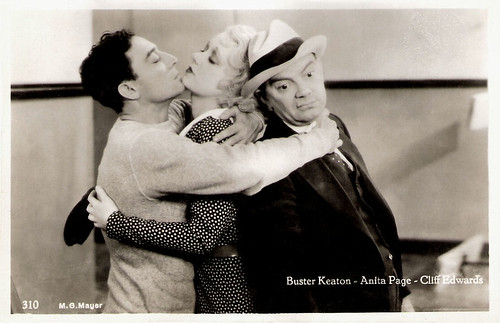
Dutch postcard by JosPe, no. 310. Photo: Metro-Goldwyn-Mayer (MGM). Publicity still for Sidewalks of New York (Zion Myers, Jules White, 1931).
The King of the Champs Elysees
Buster Keaton was so demoralized during the production of What! No Beer? (Edward Sedgwick, 1933) that MGM fired him after the filming was complete, despite the film being a resounding hit. In 1933, he married his nurse, Mae Scriven, during an alcoholic binge about which he afterwards claimed to remember nothing. Scriven herself would later claim that she didn't know Keaton's real first name until after the marriage. When they divorced in 1936, it was again at great financial cost to Keaton.
In 1934, Keaton accepted an offer to make an independent film in Paris, Le Roi des Champs-Élysées/The King of the Champs Elysees (Max Nosseck, 1934) with Paulette Dubost. In England, he made another film, The Invader/An Old Spanish Custom (Adrian Brunel, 1936).
Upon Keaton's return to Hollywood, he made a screen comeback in a series of 16 two-reel comedies for Educational Pictures. Most of these are simple visual comedies, with many of the gags supplied by Keaton himself, often recycling ideas from his family vaudeville act and his earlier films. The high point in the Educational series is Grand Slam Opera (Buster Keaton, Charles Lamont, 1936), featuring Buster in his own screenplay as a contestant in a radio amateur hour show hoping to win the first price... by dancing and juggling.
When the series lapsed in 1937, Keaton returned to MGM as a gag writer, including the Marx Brothers films At the Circus (Edward Buzzell, 1939) and Go West (Edward Buzzell, 1940), and providing material for Red Skelton. He also helped and advised Lucille Ball in her comedic work in films and television. In 1939, Columbia Pictures hired Keaton to star in ten two-reel comedies, running for two years. The director was usually Jules White, whose emphasis on slapstick and farce made most of these films resemble White's Three Stooges comedies. Keaton's personal favourite was the series' debut entry, Pest from the West (Del Lord, 1939), a shorter, tighter remake of The Invader (1936). Keaton's Columbia shorts rank as the worst comedies he made.
Image may be NSFW.
Clik here to view.
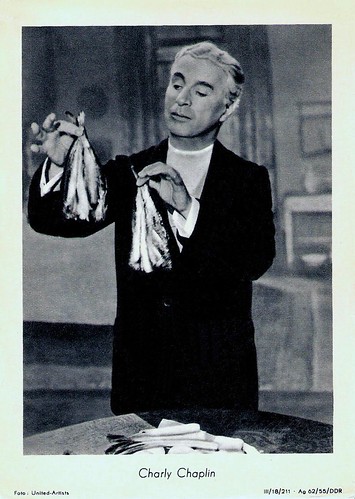
Charlie Chaplin. East-German collectors card, no. III/18/211, 1955. Photo: United Artists. Publicity still for Limelight (1952).
Another chance at the brass ring
Buster Keaton's personal life stabilized with his 1940 marriage with Eleanor Norris, a 21-year-old dancer. She stopped his heavy drinking, and helped to salvage his career. He abandoned Columbia for the less strenuous field of feature films. Throughout the 1940s, Keaton played character roles in features. He made his last starring feature El Moderno Barba Azul/Boom In The Moon (Jaime Salvador, 1946) in Mexico.
Critics rediscovered Keaton in 1949. He had cameos in such films as In the Good Old Summertime (Robert Z. Leonard, 1949), Sunset Boulevard (Billy Wilder, 1950), and Around the World in 80 Days (Michael Anderson, 1956), and did innumerable TV appearances. Keaton also appeared in a comedy routine about two inept stage musicians in Charlie Chaplin's Limelight (1952).
In 1954, Keaton and his wife met film programmer Raymond Rohauer, with whom the couple would develop a business partnership to re-release Keaton's films. Around the same time, after buying the comedian's house, the actor James Mason found numerous cans of Keaton's films. Keaton had prints of the features Three Ages, Sherlock, Jr., Steamboat Bill, Jr., College (missing one reel) and the shorts The Boat and My Wife's Relations, which Keaton and Rohauer transferred to safety stock from deteriorating nitrate film stock. Unknown to them at the time, MGM also had saved some of Keaton's work: all his 1920-1926 features and his first eight two-reel shorts.
In 1962 came a retrospective at the Cinematheque Francaise in Paris, and in 1965 a tribute at the Venice Film Festival. "I can't feel sorry for myself," he said in Venice. "It all goes to show that if you stay on the merry-go-round long enough you'll get another chance at the brass ring. Luckily, I stayed on."
In 1960, Keaton had returned to MGM for the final time, playing a lion tamer in an adaptation of Mark Twain's The Adventures of Huckleberry Finn (Michael Curtiz, 1960). Later Keaton played a cameo in It's a Mad, Mad, Mad, Mad World (Stanley Kramer, 1963) and starred in four films for American International Pictures: Pajama Party (Don Weis, 1964), Beach Blanket Bingo (William Asher, 1965), How to Stuff a Wild Bikini (William Asher, 1964) and Sergeant Deadhead (Norman Taurog, 1964). As he had done in the past, Keaton also provided gags for the four AIP films.
In 1965, Keaton starred in the short film The Railrodder (Gerald Potterton, Buster Keaton, 1965) for the National Film Board of Canada. Wearing his traditional pork pie hat, he travelled from one end of Canada to the other on a railway motorcar, performing a few stunts similar to those in films he did 50 years earlier. The film was Keaton's last silent screen performance.
He also played the central role in Samuel Beckett's Film (Alan Schneider, 1965) and travelled to Italy to play a role in Due Marines e un Generale/War Italian Style (Luigi Scattini, 1965), with Italian comedy duo Franco Franchi and Ciccio Ingrassia.
Keaton's final film was A Funny Thing Happened on the Way to the Forum (Richard Lester, 1966) which was filmed in Spain in September-November 1965. He amazed the cast and crew by doing many of his own stunts. Shortly after completing the film, Keaton died of lung cancer in 1966 at his home in Woodland Hills, California. He was 70. In 1987, the documentary, Buster Keaton: A Hard Act to Follow, directed by Kevin Brownlow and David Gill, won two Emmy Awards.
One Week (1920). Source: (YouTube).
Trailer for The General (1927). Source: Fandor Movie Trailers (YouTube).
The Railrodder (1965). Source: NFB (YouTube).
Sources: Roger Ebert, Nicolette Olivier (IMDb), New York Times, Wikipedia, and IMDb.